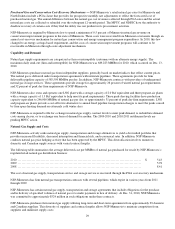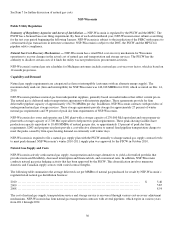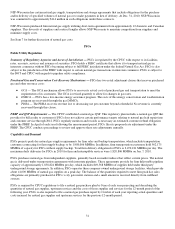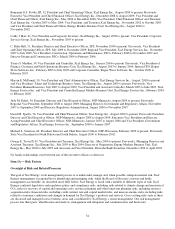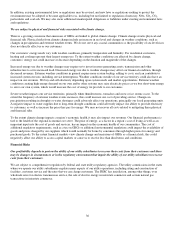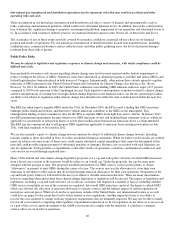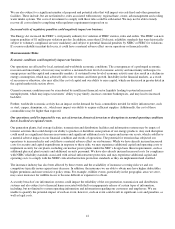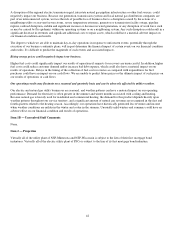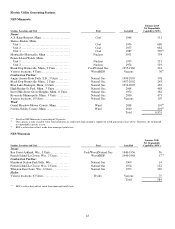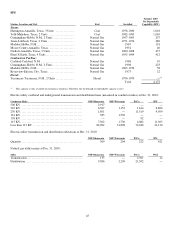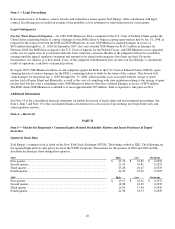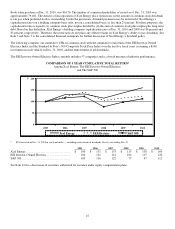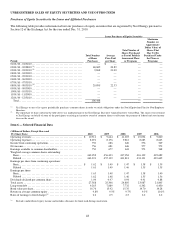Xcel Energy 2010 Annual Report Download - page 48
Download and view the complete annual report
Please find page 48 of the 2010 Xcel Energy annual report below. You can navigate through the pages in the report by either clicking on the pages listed below, or by using the keyword search tool below to find specific information within the annual report.38
One alternative available to address counterparty credit risk is to transact on liquid commodity exchanges. The credit risk is then
socialized through the exchange central clearinghouse function. While exchanges do remove counterparty credit risk, all
participants are subject to margin requirements, which create an additional need for liquidity to post margin as exchange positions
change value daily. The recently enacted Dodd-Frank Wall Street Reform Act may require broad clearing of financial swap
transactions through a central counterparty, which may lead to additional margin requirements that could impact our liquidity.
Also, in October 2010, the FERC finalized its rulemaking addressing the credit policies of organized electric markets, such as
MISO and SPP, which may lead to additional margin requirements that could impact our liquidity.
We may at times have direct credit exposure in our short-term wholesale and commodity trading activity to various financial
institutions trading for their own accounts or issuing collateral support on behalf of other counterparties. We may also have some
indirect credit exposure due to participation in organized markets, such as PJM and MISO, in which any credit losses are
socialized to all market participants.
We do have additional indirect credit exposures to various financial institutions in the form of letters of credit provided as security
by power suppliers under various long-term physical purchased power contracts. If any of the credit ratings of the letter of credit
issuers were to drop below the designated investment grade rating stipulated in the underlying long-term purchased power
contracts, the supplier would need to replace that security with an acceptable substitute. If the security were not replaced, the
party would be in technical default under the contract, which would enable us to exercise our contractual rights.
Increasing costs associated with our defined benefit retirement plans and other employee benefits may adversely affect our
results of operations, financial position or liquidity.
We have defined benefit pension and postretirement plans that cover substantially all of our employees. Assumptions related to
future costs, return on investments, interest rates and other actuarial assumptions have a significant impact on our funding
requirements related to these plans. These estimates and assumptions may change based on economic conditions, actual stock
market performance, changes in interest rates and changes in governmental regulations. In addition, the Pension Protection Act of
2006 changed the minimum funding requirements for defined benefit pension plans beginning in 2008. Therefore, our funding
requirements and related contributions may change in the future. Also, the payout of a significant percentage of pension plan
liabilities in a single year due to high retirements or employees leaving the company would trigger settlement accounting and
could require the company to recognize material incremental pension expense related to unrecognized plan losses in the year
these liabilities are paid.
Increasing costs associated with health care plans may adversely affect our results of operations.
Our self-insured costs of health care benefits for eligible employees and costs for retiree health care plans have increased
substantially in recent years. Increasing levels of large individual health care claims and overall health care claims could have an
adverse impact on our operating results, financial position, and liquidity. We believe that our employee benefit costs, including
costs related to health care plans for our employees and former employees, will continue to rise. Legislation related to health care
could also significantly change our benefit programs and costs.
We must rely on cash from our subsidiaries to make dividend payments.
We are a holding company and our investments in our subsidiaries are our primary assets. Substantially all of our operations are
conducted by our subsidiaries. Consequently, our operating cash flow and our ability to service our indebtedness and pay
dividends depends upon the operating cash flow of our subsidiaries and the payment of funds by them to us in the form of
dividends. Our subsidiaries are separate legal entities that have no obligation to pay any amounts due pursuant to our obligations
or to make any funds available for that purpose or for dividends on our common stock, whether by dividends or otherwise. In
addition, each subsidiary’s ability to pay dividends to us depends on any statutory and/or contractual restrictions that may be
applicable to such subsidiary, which may include requirements to maintain minimum levels of equity ratios, working capital or
assets. Also, our utility subsidiaries are regulated by various state utility commissions, which generally possess broad powers to
ensure that the needs of the utility customers are being met.
If our utility subsidiaries were to cease making dividend payments, our ability to pay dividends on our common stock and
preferred stock or otherwise meet our financial obligations could be adversely affected.



